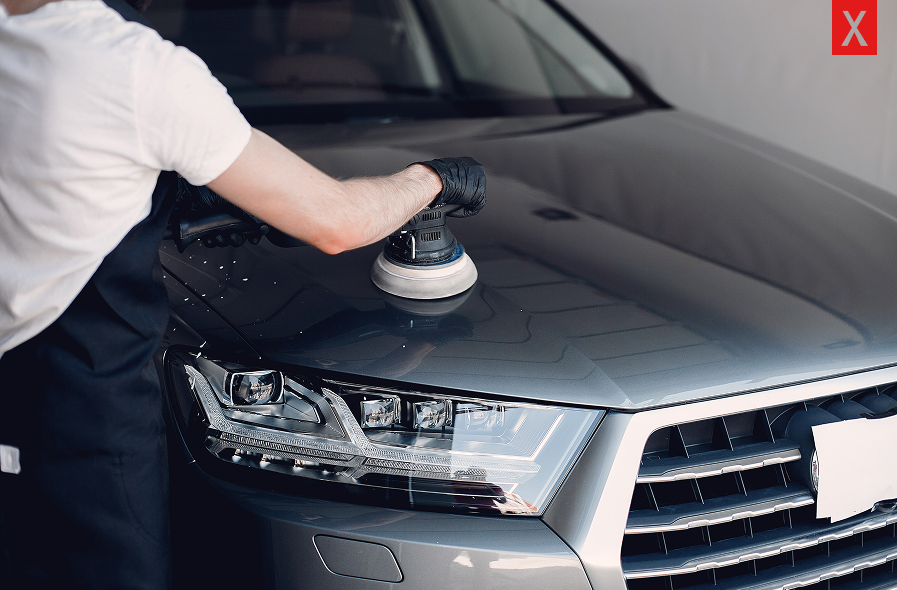The paint of a car is the first thing anyone notices, and it is often the first thing to wear. If you don’t treat it in time, it can go from a few tiny scratches and swirl marks to looking completely dull and faded over time. Therefore, keeping the paint in good condition is essential to preserving the car’s shine and value.
If you need help to fix your car’s paint, this guide discusses all the basics of paint correction services you’ll want to know about. Let’s get started!
Article Highlights
In this article, you will learn about:
- Car Paint Correction Process
- Common Car Body Paint Issues
- How to Choose a Car Body Shop for Paint Correction
What is Paint Correction?
Paint correction is performed by trained technicians using special equipment and products to restore your car’s original look and finish. It’s a multistep process that removes any swirl marks, light scratches, and oxidation from your car’s clear coat. Paint correction does not involve fresh paint. It only removes imperfections in the clear coat.
Paint Correction Step by Step Process
1. Inspection and Assessments
The process starts with the technician inspecting your vehicle to evaluate the amount of damage to the paint. This makes sure that the vehicle only receives paint correction where it’s required.
2. Surface Decontamination
Next, your vehicle is thoroughly washed and then treated with a clay-like material to remove contaminants.
Get Your Car Looking New Again!
Our skilled team brings your damaged car body back to its original condition expertly.
3. Paint Masking
Paint masking is done to prevent polish contamination in rubber trims or plastic parts of your car. It also ensures clean edges to proceed for the next step.
4. Compounding
Compounding process involves a machine polisher with cutting pads to remove minor scratches, swirl marks, or bumper scuffs that haven’t penetrated the clear coat, restoring paint uniformity.
5. Polishing
This process involves using a machine polisher with finer polishes and softer foam pads to remove haze or micro-marring from compounding, enhancing shine and clarity. Multiple pad-polish combinations may be used based on paint imperfections.

6. Refining & Gloss Enhancement
Once major imperfections are removed, a special polish is applied to enhance gloss and lustre. This stage removes any minor haze left from car polishing.
7. Final Inspection
Technicians use a specific panel prep process to remove polish residues, revealing the true condition of the paint. Final visual and lighting checks are then carried out to ensure a shiny finish for your car’s body paint.
8. Paint Protection
Lastly, the technician will use a paint protection film (PPF), wax, sealant, or ceramic coating to protect the corrected surface from future damage and maintain the finish for longer.
Need Car Body Repair?
Get a free assessment and quote from our certified technicians today!
Common Signs of Paint Damage
Knowing when to seek expert help can help you avoid further damage. Here are the most common signs that your car needs paint correction.
Swirl Marks: Swirl marks look like circular scratches and usually happen when washing with rough sponges.
Light Scratches: These are shallow marks that occur from unexpected scrapes. They can be easily fixed at auto paint scratch repair shops, often within the same day.
Oxidation: It’s a dull and chalky appearance that happens when the paint job on the car loses its protective layers due to prolonged sun exposure.
Water Spots: These are formed after prolonged rain exposure. They can make the car paint appear dull and stained if not removed quickly.
Bird Droppings: Parking your car under a tree often leads to bird droppings. These are acidic and can damage your car’s clear coat if you don’t remove them in time.
Book Your Repair Today!
Your car deserves the best care. Book your car body repair now and enjoy fast, reliable service.
How to Choose the Right Paint Repair Shop?
Request for an in-person assessment before accepting any quotes. Choose a body shop that is experienced with cosmetic paint repair and detailing. Ensure that the technicians you choose are well-trained and use high-quality tools and products to provide long-lasting results. You should also check the customer reviews and ask for pictures from previous jobs before making any commitments.
Frequently Asked Questions
The cost of car paint correction depends on the size and severity of the damage. Correcting large or severe damage is usually more expensive than correcting minor damage.
It depends on the quality of materials used. Cheap materials only last for a few months while high-quality materials can last for several years with proper care.
Paint correction does not fix paint chips. It only improves the existing paint on the car and does not involve applying fresh paint.
Choose AVX for Car Paint Correction Services
If you want to restore your car’s shine without a costly respray, AVX offers expert paint correction services tailored to your requirements. From dent removal to multi-stage detailing, our specialists can help bring back your car’s original finish expertly. Get in touch to learn more.



